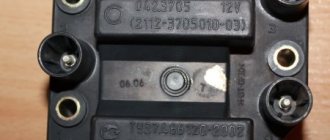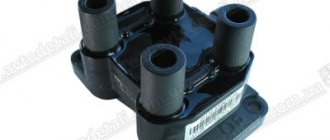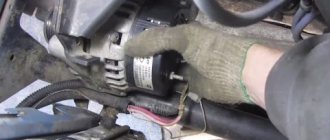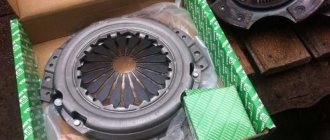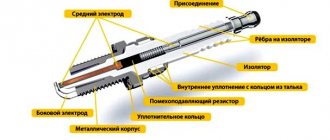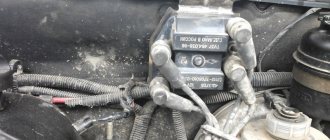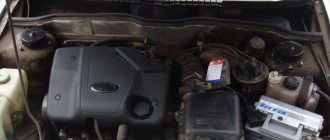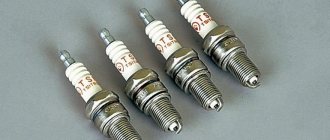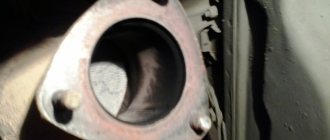It's no secret that a spark is needed to ignite fuel. It is formed by the so-called ignition system. And no, the system does not represent one or several elements - it is a real system, which in modern cars is also smart, if you can talk about it that way. The system is responsible for timely ignition and the most efficient use of available fuel. The ignition coil is just one of its components. Many people confuse the coil with the ignition module. These devices have the same operating principle, but differ, firstly, technically, and, secondly, in their areas of application. Let's figure out how the ignition module works, what can damage it and how to find a replacement for it.
What is the difference between a module and an ignition coil?
The ignition control module, as it is more correctly called, is essentially one of the control elements. It controls the ignition coil, and also sets the ignition timing and, if necessary, changes it. Of course, in accordance with the commands given by the car ECU. The design of the ignition module includes the following elements:
- Keys ( high voltage );
- A pair of ignition coils.
Optionally, an electronic switch can be used. The control unit is responsible for generating control signals that are clearly consistent with the position of the vehicle's crankshaft. As soon as the signal period comes to an end, spark ignition begins - this is how the ECU controls the module, which controls the coils. Typical module malfunction: loss of ignition in a pair of cylinders. In this case, they say that one channel is out. Often the ignition remains normal, but is unstable when the engine is cold. We will look at these points later.
In the vast majority of modern cars with modern internal combustion engine control systems, the module has given way to four-terminal ignition coils. Let us recall that the ignition coil is essentially a step-up transformer - there is a low voltage at the input and a high voltage at the output. On cars with 16V , there are four ignition coils, so there are problems with the ignition system. There is only one module, it is controlled by a computer and, roughly speaking, is an evolution of the usual ignition coils (many call this a new generation of coils).
So what is the advantage of modules?
Older carburetor engines had a coil that worked in tandem with a distributor. Engineers decided to use a module in injection engines. According to experts from ]Beru[/anchor], one of the leading manufacturers of ignition system components, the future of internal combustion engines lies in the ignition coil block ( module ), in which the elements operate independently of each other. Structurally, this is advantageous because each element does not require a large number of connecting wires. And the system itself turns out to be more reliable, especially when compared with the ignition of older models. Car enthusiasts are thinking about replacing conventional coils with a module for other reasons:
- Misfire . It is more difficult to start the engine when cold, the car consumes more fuel, etc.;
- The coils are burning . Many people complain that the coils fail very quickly and literally one after another;
- Repair price . Rather a corollary from the previous point. Good reels made in Japan or Germany cost a lot of money. The module includes everything necessary for the operation of the ignition system and boasts high fault tolerance and reliable operation in almost any conditions.
Ignition models also have their own “diseases,” but they are few and progress slowly. As a rule, module failure occurs due to an interturn short circuit. It is preceded by a break in the high-voltage wire. The module will still work , but much less efficiently. Perhaps this is the only serious problem that those car enthusiasts who decide to remake the ignition system may encounter.
Ignition module malfunctions
It is very easy to identify the main malfunctions of the ignition module. A car enthusiast should acquire an accurate device for measuring active resistance. The reasons for its use may be the following:
- Weak discharge on a candle, several candles or all of them;
- No spark discharge.
Obviously, all of the above is the cause of increased fuel consumption, malfunctioning engine operation, and increased exhaust toxicity. Everything that is typical for faulty spark plugs is transferred to the module. You can check it yourself, as in the case of a spark plug: between spark plugs (more precisely, terminals) 1-4, as well as 2-3, the resistance should not be less than 4000 Ohms . If it is smaller, then we can talk about a turn circuit. The normal resistance depends on who manufactured the module. In most cases this is 4000-5000 Ohms .
Some problems with automotive ignition modules are related to the switch. It is a board consisting of a number of microcircuits that are filled with a special heat-removing gel. The device can be found behind the module on a large metal plate. Module malfunctions are observed when the connections of the coils and the switch become unusable. The easiest way is to replace the entire module, but car enthusiasts who are well-versed in repairing electronic boards can try to make the repairs themselves.
Signs of malfunction of the ignition module of VAZ 2110 and 2114. We disassemble and fix
This electrical unit is more modern than on the “classic”, but it is quite possible to identify signs of a malfunction in the ignition module of the VAZ 2110 and 2114 even for a novice car enthusiast. Of course, provided that there is a desire to engage in such testing. This is not such a primitive design as the classic so-called bobbin, but the module also cannot be called a super complex thing. Therefore, self-diagnosis is accessible even to a beginner. But the solution to the problem itself is your choice: either replacement or repair with your own hands, or a trip to a familiar service station. Signs of a malfunction of the ignition module of the VAZ 2110 and 2114, as a rule, can be identified in several cases of abnormal operation of parts and components. We will talk about this in our article today. Floating speed: The situation when the idle speed of a running engine without any action taken by the driver begins to change spontaneously is usually called “floating speed”. Moreover, they can vary their performance so much that the engine sometimes stalls. Of course, this factor may also indicate a malfunction of some other mechanisms that are no less important for the smooth operation of the machine. For example, incorrect ECU settings or clogged injectors. These same signs may indicate poor quality of the fuel being poured. So the situation when the speed floats at idle can only be called an indirect indicator. The engine is doubling, not to be confused with tripling! That is, not one cylinder is not working, but a pair: either 1/4 or 2/3. Well, this sign is quite easy to determine by listening to the operation of the car’s engine. This is also clearly felt by the vibrations and sounds of the functioning of the running engine. You may also feel dips in traction when trying to accelerate or when driving up a hill, albeit a small one. Another indirect sign indicating a malfunction of the ignition module is the Check Engine light. True, the light bulb can light up for various reasons (and even without them). Computer diagnostics If you carry out scanning diagnostics using the appropriate equipment, you can understand from the identified errors that the ignition module is sinning.
- P3000 (and also 3001-3004) – the ignition in the cylinders does not work;
- P0351 – winding break in a pair of 1/4 cylinders;
- P0352 – winding breakage in a pair of 2/3 cylinders.
If you discover any of these errors using a smart machine, do not rush to get too upset, since they do not necessarily indicate the death of this node. For example, high-voltage wires with breakdown or spark plugs can also create a problem. Therefore, professional diagnosticians advise going from small to great: that is, at the beginning, exclude more correctable and minor symptoms, taking on large and global ones last. And only after checking other elements of the ignition system for malfunctions: unscrewing and inspecting the spark plugs, for example, ringing and replacing the wires, then begin diagnosing the problems of the corresponding module. How to check? Professional car service technicians advise the simplest method of checking. To do this, install a known-good ignition module instead of the one being tested.
- Remove the negative from the battery (disconnect the terminal);
- Remove the tips from the spark plugs;
- We press out the fastening clamp. Disconnect the wire block from the ignition coil;
- We unscrew the fastenings of the gearbox bracket, as well as the lower bolt on the cylinder block fastening;
- We take out the ignition coil together with the bracket, disconnect the wires;
- We release the fastening of the bracket and coil;
- We remove the coil and replace it with a known-good similar device. Reassemble in reverse order;
- If everything works, then the problem is in the ignition coil. As a rule, it is not repaired, but simply replaced with a new device. So you’ll have to run to the nearest auto store or car market to get the required spare part.
A little advice: when reinstalling, it is necessary to correctly connect the high-voltage wires leading to the coil and to the spark plugs.
By the way, there are marks on them so that you definitely don’t miss. So pay attention to this nuance so as not to create additional troubles. What to do if there is no working module? If it is not possible to install a test element or borrow it for a while, for example, from a neighbor in the garage, then you will have to be patient when picking up test lamp and multitester. We measure the resistance between the winding terminals (paired). The probes must be installed according to the scheme: 1/4, 2/3. The measurement results should be almost identical (approximately 5.5 kOhm is shown by the device). If the errors between them are 100 Ohms or more, the module needs to be replaced, since the secondary winding has failed. Next, in order to identify signs of a malfunction in the ignition module of the VAZ 2110 and 2114, we call the wire block and check the serviceability of the ECU. If you don’t have a multitester at hand, some testing steps can be carried out using a test light. AutoFlit.ru
If the module does not have a built-in switch
Some modules do not have a switch. The manual for them says “dual ignition coil”. Since such modules do not have switches, their main faults are related to the coils. In rare cases, the problem lies in the ECU. Note: the ignition system still has a switch, but it is a separate element. Checking the coils with a multimeter should show the following:
- The primary winding must have a resistance of over 3000 Ohms ;
- The resistance of the secondary winding cannot be less than 4000 Ohms .
An important point: the measuring device has a measurement error, but it should not be greater than the difference between the coils of different pairs of leads. One more point: in very rare cases, the secondary winding shorts to vehicle ground. Such a malfunction is very difficult to identify. In almost all cases, the breakdown of the secondary winding occurs through microcracks that cover the module body after long-term operation. One output breaks through, so that out of a pair of candles only one stops working.
What errors are associated with the ignition module?
Fortunately, the ECU system controller will help us determine whether the ignition module is faulty. She constantly “monitors” that there are no breaks in the ignition system. The DTC is displayed under the following conditions:
- The driver turns on the ignition;
- The system checks whether the condition for setting the code is met;
- It is determined whether there is an open circuit, whether there is a short to ground or a short to battery;
- The lamp lights up, signaling a malfunction;
- The controller records a diagnostic trouble code.
These errors are directly related to the operation of the ignition module:
- A break in the coil of cylinder 1-4 was detected;
- A broken coil of cylinder 2-3 was detected;
- P3000, as well as P3001 to P3004. Multiple misfires detected.
Please note: errors could occur due to non-functioning spark plugs or a broken high-voltage wire. They need to be checked, as well as the ignition module . It is recommended to replace the latter if it is faulty - the unit can be called repairable only conditionally.
Procedure for checking the ignition module on a Chevrolet Niva
Before proceeding with dismantling the module, you need to make sure that the cause of unstable operation is not a simple lack of power contact. To do this, we “move” or turn on and off the connected block of wires several times. If such a procedure does not bring any results, then the functionality should be checked on a dismantled device.
- When the element is removed, we prepare the multimeter for use and check the integrity and cleanliness of the sockets on the terminals (A, B, C, D - approx.).
- First of all, connect the red probe to contact – D, the second one to ground. We turn the multimeter into voltmeter mode - 20 volts, and if the socket is working, then the readings on the tester should be 12 volts.
- Next, go to contact – C, the second again to ground. We switch the multimeter to the ohmmeter mode and look at the readings of the device, and if it is less than 1 ohm, then the socket is normal.
- We check contacts A and B one by one, but in the same order. We connect the multimeter in voltmeter mode and if the readings do not exceed 0.3 volts, then the device can be considered fully working.
What a car enthusiast can do on his own
Everything that was stated above. Working with a measuring device does not always give the result in which you can be confident. The fact is that the winding resistance values of different modules may be different. It's best to do the following:
- Go to the service center and ask the technician to check the module on a special stand. Such stands can be either made at the factory or made in a garage. The second option should not scare you: homemade stands are usually made from a distributor removed from a carburetor “nine” and a drill drive;
- Install a known working ignition module on the car and see how it behaves. Obviously, the car enthusiast will need to monitor the operation of the spark plugs.
All 3 options are good in their own way. The vehicle owner should always have measuring instruments - the lion's share of automotive electronics can be diagnosed in a garage and determined whether sensors, coils, modules, etc. need to be replaced. The remaining 2 options are more accurate, but require compliance with conditions.
Repair of the VAZ 2110 ignition module
A car's engine management system consists of many elements, each of which is important in its own way. If from time to time you lose high voltage on one or more cylinders, then one of the reasons for this ailment may be a faulty ignition module (IM). Please try to repair it before replacing it with a new one. The ignition module consists of:
- Ignition coil (2 pcs), they generate high-voltage pulses to pairs of spark plugs
- Dual channel switch.
If the ignition module does not work properly, then there may be various signs: interruptions in engine operation, unexpected stopping, etc., and the “Check Engine” lamp does not light up. Diagnosis and repair of the ignition module is quite simple, provided that you have basic knowledge of electrical engineering. In addition, you need to be able to work with a digital multimeter. Before diagnosing the ignition module, you must make sure that other engine systems are working properly. It is not uncommon for system elements to experience malfunctions that appear for a very short period of time and immediately disappear. Such failures are not detected by the “Check Engine” lamp, but the controller stores them in memory. When reading errors from the controller, the tester does not find these faults (i.e. there was a fault, but at the moment it is not). The cause of such troubles can be: unreliable contact connections, contact contamination, unreliable fastening of the ground contacts, electrical interference, etc. .d. Let's look at one of the reasons for the breakdown of the ignition module in more detail:
DIY ignition module repair
In this case, the car sometimes loses high voltage on cylinders 2 and 3. After some time, it was noticed that the engine began to work normally if the rear plate of the ignition module was slightly pressed. It was decided to restore the functionality of this unit. First you need to remove the VAZ 2110 ignition module (instructions).
| First of all, we tear off the aluminum plate using a straight screwdriver. |
| Inside the box you can see a small printed circuit board with electronics. The entire board is covered with a layer of transparent silicone, which must be removed. The wires that connect the board to the contacts of the connectors and coils are made of soft aluminum, so they broke quite quickly. |
| We tear off all the wires from the contacts; instead, multi-core wires (from a computer mouse) will be used. |
| The ignition module circuit consists of two L497D1 switches and two powerful BU931 type transistors. Because Since the contacts turned out to be made of aluminum, they should be soldered with a special flux for aluminum. |
Procedure:
- Solder the wires to the board. Soldering the wires to the transistor collectors will be more difficult, because... they are coated with a special metal that is difficult to solder. You will need to carefully remove the top coating from this metal. To prevent all the heat from dissipating across the plate when you touch it with a soldering iron, you need to put it on the stove and heat it to about 180°.
- We solder the wires to the contacts in the module, while trying to make the wires as short as possible.
- We cover the soldering areas with varnish (for example, for nails).
We check the ignition module for functionality and then coat the inner surface with autosealant and perform final assembly. After assembly, the wires should be positioned freely, making sure that they are not pinched inside the box. If the cause of the malfunction was not poor contact, then you will have to look for the cause elsewhere, or replace the ignition module with a new one.
In conclusion, it will be useful for experienced electricians to know that the L497D1 switch costs about $3, the BU931 transistor costs about $6. The transistor can be replaced with the domestic KT848A, it is cheaper, but its dimensions are much larger.
xn--2111-43da1a8c.xn--p1ai
How to choose a car ignition module
When choosing a module, a car enthusiast may be faced with the fact that in the store there are two modules that look identical at first glance: an old one and a new one. They are not interchangeable. There is confusion in concepts: sellers in stores call modern coils modules, although they essentially are not them. But let’s not deviate from the “store concept” and look at the features of both modules.
Spare parts for Opel astra
Ignition module (switch)
ASTRA G sedan (F69) (09.98 - 12.09)
Spare parts for Mercedes e-class
Ignition module (switch) E-Class sedan (W124) (12.84 - 06.93)
Old-style modules (roughly speaking, having 4 connection wires) have a built-in signal amplifier. The new model modules do not have such an element, and the transistors, also known as high-voltage switches, are located directly in the “brains” of the engine. If you really want to install a new type of module, you will also have to change the ECU with wiring or try to introduce transistors into the system. The work is not easy, and there is not much point in it. To accurately select the module you need, use the following search methods:
- By VIN code . This is the simplest and most accurate method of searching for original spare parts and their closest analogues;
- According to the car . We are interested in: car make, model, engine data. The ECU data is directly connected to the engine. Simply put, if you select a module according to the technical data of the car, then you definitely won’t have the idea of looking for a part for a car with a 16-valve engine or an 8-valve one;
- According to the spare part code . Usually the car owner does not have the code for the required module. You can find the spare part code in the electronic catalog using the above method: brand - model - ... - the spare part you are looking for. Advanced systems automatically add analogues to the list of suitable ignition modules, which is very convenient.
Choosing the wrong module risks at least the fact that the device will not be able to be installed on your car. Modules of old and new models differ from each other - this should not be forgotten. If a car enthusiast decides to remake the ignition system with individual coils, then he needs a new model module (often sellers describe it simply as a “small” module), connector and wiring. The ECU will need to be flashed.
Estimated cost
A new ignition module for Lada 2110 can be purchased for 950-3860 rubles . Prices for parts of different brands are shown in the table.
| Parts brand | Company manufacturer | Country of issue | Which VAZ 2110 engine is the part compatible with? | Cost in rubles |
| BOSCH K101 | BOSCH | Germany | 1.6L, 8 valves | 3860 |
| SOATE | SOATE | Russia | 1.6L, 8 valves | 1400 |
| OMEGA K101 | OMEGA | Russia | 1.5L, 16V | 2190 |
| SOATE | SOATE | Russia | 1.5L, 16V | 2690 |
| REMCOM | REMCOM | Russia | 1.6L, 8 valves | 950 |
| StartVolt SC 0111 | StartVolt | Russia | 1.6L, 8 valves | 1040 |
| FENOX IC16004O7 | FENOX | Belarus | 1.6L, 8 valves | 1550 |
| HOFER HF750304 | HOFER | Germany | 1.6L, 8 valves | 1000 |
A used ignition module for a VAZ 2110 can be purchased for 500-900 rubles .
The approximate cost of used parts, depending on the car brand and condition, is shown in the table below.
| What car is the spare part from? | State | Cost of the part in rubles |
| Lada 2110 | good | 500 |
| Lada 2110 | perfect | 700 |
| Lada 2112 | good | 600 |
| Lada 2112 | perfect | 900 |
| Lada 2109 | good | 500 |
| Lada 2115 | perfect | 850 |
If the part is purchased in another region, or online store, then you will have to order its delivery. This service costs about 300-500 rubles .
Brand tour
Today, most ignition modules are manufactured by only a couple of companies. They control most of the market, and, which is favorable for the car enthusiast, the quality of the products is consistently high. He can’t go wrong by purchasing an original module or the closest analogue from the following companies:
- Bosch (Germany);
- Lucas (UK);
- Era (Italy);
- Stellox (Germany);
- Delphi (UK).
With the exception of Stellox, the car enthusiast will be able to find the same original under the name of the above brands. For example, Era is a packer and works closely with Siemens VDO, Pierburg, Bosch and many others - those whose products are the standard of quality. It is also worth noting the ]NGK[/anchor] ignition modules (Japan) - they are not inferior in quality to Delphi , but are often cheaper.
Types of spare parts
Depending on the manufacturer, you can purchase an original and non-original ignition module. Spare parts from Lada are suitable for VAZ 2110:
- 2110.
- 2111.
- 2109.
- 2112.
Based on the country of production, auto parts are divided into domestic and imported.
You can buy spare parts from the following manufacturer:
- AvtoVAZ.
- SOATE.
- Delphi.
- BOSCH.
- FENOX.
- HOFER.
- ATE-2.
- Lucas.
You can purchase a car part for a VAZ 2110 with a 1.5-liter or 1.6-liter engine.
SOATE ignition module
Depending on the condition, the spare part may be:
- New.
- Used.
Used spare parts are as follows:
- In perfect condition.
- In a good condition.
- Requiring minor repairs.
At the place of purchase, the part may be:
- Purchased at a vehicle dismantling point.
- Ordered from the online store.
- Purchased through an advertisement from a private individual.
- Bought at a car market.
Conclusion
If the ignition module fails, the problem cannot be ignored. Firstly, the power performance of the engine will drop significantly. Secondly, the ride will become less comfortable. Thirdly, the exhaust will become more toxic, and this causes great harm to the environment. In fact, choosing the right module is very simple. You just need to be guided by the technical data of the vehicle, spare part code or vehicle identification number. There is also no difficulty in choosing a manufacturer: all products from well-known companies can boast of high quality workmanship, high fault tolerance and durability.
Factors influencing the cost level
Buying an ignition module for a VAZ 2110 can cost varying amounts of money. The price of such spare parts depends on the following factors:
- Originality.
- State.
- Quality.
- Company manufacturer.
- Place of purchase.
- Delivery required.
- Sales region.
- Seller's pricing policy.
HOFER ignition module
